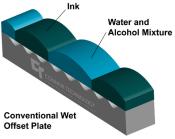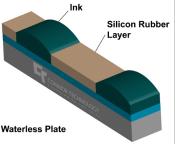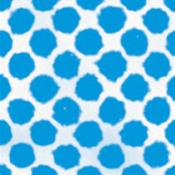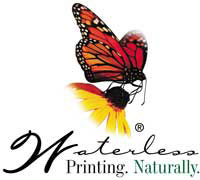What is Waterless Printing?

Unsupported ink is in direct contact withthe water and chemical dampening solution.
 Silicone rubber layer provides supportive walls for ink.
Silicone rubber layer provides supportive walls for ink.Waterless printing is an offset lithographic printing process that eliminates the water or dampening system used in conventional printing. It uses a special silicone rubber coated printing plate, special ink, and typically a means of temperature control on press.
In waterless printing the process of printing is changed from a chemical one involving the use of Isopropyl Alcohol or their substitutes to a simplified mechanical process. Instead of the press operator balancing the delicate relationship between ink and water, all that waterless printing requires is a temperature range for transferring ink to the substrate.
Topknotch's Kodak digital waterless press offers a high quality finished product efficiently, without creating any chemical waste. You can expect a cleaner, sharper and more consistent final product when using a waterless prress when compared to conventional wet offset presses. Using waterless plates reduces clean up and makeready time by eliminating the darkroom, chemical processing and baking. Imaging plates can be done within 5 minutes, and can begin printing immediately after cleaning. With a top speed of 7000 iph (impressions per hour), you can expect a quick turnaround from proof to finished product. In addition to time and money savings, choosing to print your job on a waterless press is also an environmentally friendly choice. Properly disposing of the heavy metals and chemical waste in film-based processes is expensive. Eliminating the alcohol dampening systems in the pressroom will also reduce a majority of the emissions in the pressroom, protecting the worker's health and reducing emissions released into the atmosphere.
Key Benefits of Waterless Printing
 Prints by conventional plate
Prints by conventional plate Prints by waterless plate
Prints by waterless plate- Consistent Color:
Eliminate the vagaries of the dampening system and you get more consistent color throughout the press run.
- Better Color Saturation:
Four-color process ink densities have averaged 20% higher than SWOP standards. A benefit designers and print buyers love.
- Low Dot Gain, More Detail:
The inherent low dot gain of waterless lets you run higher screen rulings for much better detail. Waterless works well, regardless of the screen rulings. Even if you run 175 line screens, you will print a better product.
- More Paper Options:
Waterless is great for printing on stock you would normally stay away from with conventional printing. 24.6% of the jobs that waterless printers produce are printed on uncoated papers. Take away dampening and many of the paper problems associated with offset printing disappear.
- Faster Makereadies: Nine different pressmen surveyed in L & E Packaging's initial study all said that makeready times were faster. One pressman reported that the time savings was 40% over conventional makeready time.
- Better for the Planet: The reduction in dampening usage and paper waste are strong benefits that are now beginning to make themselves felt among those concerned with environmental issues.
Environmental Breakthroughs

Butterflies are a litmus test of our environment.
- Clean air
Many printers have been drawn to waterless printing because it eliminates dampening-related volatile organic compounds (VOCs) from the printing process. Some VOCs have been linked to the deterioration of the earth's protective ozone layer and, consequently, to global warming. Now, with the release of water-washable inks, the waterless pressroom can be virtually VOC-free.
This revolutionary ink technology, eliminates the need for solvent-based press and blanket wash solutions, which typically account for a large portion of a printer's VOC output. The press wash solution is 93% water and 7% mild surfactant (soap), with the ultimate goal of a 100% water-washable product.
The environmental benefits of water-washable inks are far reaching. In some cases the elimination of pressroom VOCs may even result in expansion opportunities that were previously limited due to emission restrictions.
- Clean, adequate water supply:
In 1995, 92% of the global population had a sufficient supply of water. If the world continues to consume water at its current rate, it is projected that water sufficiency in 2050 will be only 58%. It is further predicted that nations will go to war over water supplies within the next two decades.
Waterless printers have recorded dramatic conservation of our water resources. A printer in Switzerland, operating one of the world's first waterless web presses, eliminated the use of approximately 250,000 litres (about 66,000 gallons) of water in one year. That water would normally have come from a nearby lake, which is a source of drinking water for tens of thousands of people.
- Forest conservation:
It takes 17 pulpwood market-sized trees to make a ton (907 kg) of paper. Barely enough to provide a daily newspaper to 20 people for a year. Besides depleting our supply of virgin fibers for papermaking, deforestation destroys the natural habitats of countless plants and animals, one of which may have otherwise provided a cure for cancer.
Because presses running waterless come up to color and register so much faster, and hold those consistently throughout the press run, paper savings of 30 percent to 40 percent have been reported. In addition to saving trees, that also represents a significant manufacturing and paper cost savings.
- Safe working conditions:
According to the National Officer for Health and Safety and the Environment, of the UK's Graphical, Paper and Media Union (GPMU), printers inhale organic solvents all day long. As reported in the November/December 1998 premier issue of the Environmental Print Journal, the undisputed effects of occupational exposure to organic solvents include damage to liver, kidneys and lungs, degreasing of the skin and dermatitis, mild and reversible effects on the nervous system and more severe effects from large acute exposure.
The GPMU stipulates that exposure is highest when printers clean the printing machines with highly volatile organic solvents, and that exposure increases where alcohol dampening is used.
Obviously, removing dampening from the press and eliminating the need for the toxic substances found in blanket wash solutions will not only ease the burden on our air, soil and water, it will help protect our most precious natural resource: Mankind
These environmental goals are universal, though the degree of concern may vary from country to country. In some parts of the world, the printing industry has been specifically cited for its contribution to the degrading environment.
For more information please visit The Waterless Printing Association.